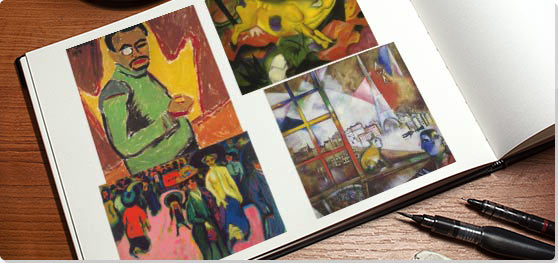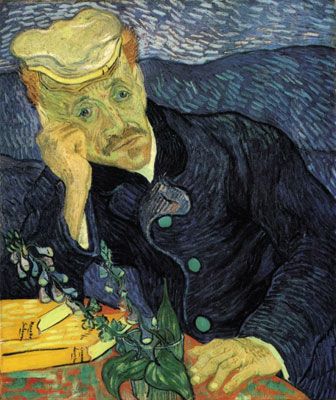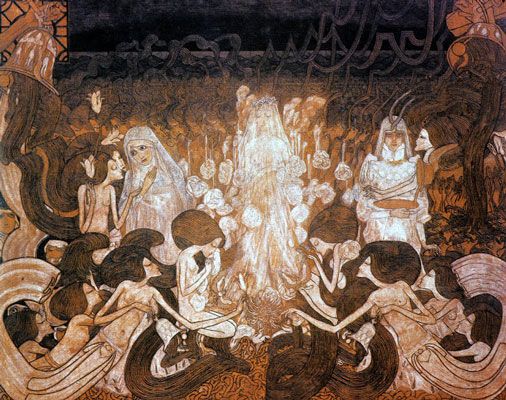Summary of Expressionism
Expressionism emerged simultaneously in various cities across Germany as a response to a widespread anxiety about humanity's increasingly discordant relationship with the world and accompanying lost feelings of authenticity and spirituality. In part a reaction against Impressionism and academic art, Expressionism was inspired most heavily by the Symbolist currents in late-19th-century art. Vincent van Gogh, Edvard Munch, and James Ensor proved particularly influential to the Expressionists, encouraging the distortion of form and the deployment of strong colors to convey a variety of anxieties and yearnings.
The classic phase of the Expressionist movement lasted from approximately 1905 to 1920 and spread throughout Europe. Its example would later powerfully inform many individuals, and groups such as: Abstract Expressionism, Neo-Expressionism, and The School of London.
Key Ideas & Accomplishments
- The arrival of Expressionism announced new standards in the creation and judgment of art. Art was now meant to come forth from within the artist, rather than from a depiction of the external visual world, and the standard for assessing the quality of a work of art became the character of the artist's feelings rather than an analysis of the composition.
- Expressionist artists often employed swirling, swaying, and exaggeratedly executed brushstrokes in the depiction of their subjects. These techniques were meant to convey the turgid emotional state of the artist reacting to the anxieties of the modern world.
- Through their confrontation with the urban world of the early-20th century, Expressionist artists developed a powerful mode of social criticism in their serpentine figural renderings and bold colors. Their representations of the modern city included alienated individuals - a psychological by-product of recent urbanization - as well as prostitutes, who were used to comment on capitalism's role in the emotional distancing of individuals within cities.
Overview of Expressionism
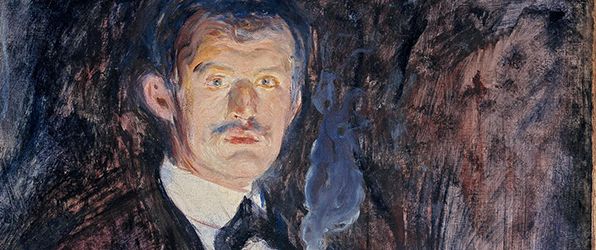
On a walk he took with two friends at sunset, Edvard Munch described how "suddenly, the sky turned as red as blood .. Tongues of fire and blood stretched over the bluish black fjord. My friends went on walking, while I lagged behind, shivering with fear. Then I heard the enormous, infinite scream of nature." Expressed in his painting The Scream (1893), his emphasis upon intense inner experience set the path for Expressionism, defined by Ernst Kirchner as mirroring "the sensations of a man of our time."
Artworks and Artists of Expressionism
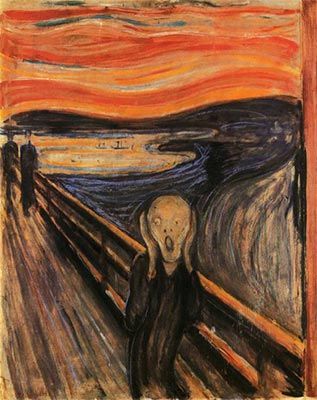
The Scream
Throughout his artistic career, Munch focused on scenes of death, agony, and anxiety in distorted and emotionally charged portraits, all themes and styles that would be adopted by the Expressionists. Here, in Munch's most famous painting, he depicts the battle between the individual and society. The setting of The Scream was suggested to the artist while walking along a bridge overlooking Oslo; as Munch recalls, "the sky turned as red as blood. I stopped and leaned against the fence...shivering with fear. Then I heard the enormous, infinite scream of nature." Although Munch did not observe the scene as rendered in his painting, The Scream evokes the jolting emotion of the encounter and exhibits a general anxiety toward the tangible world. The representation of the artist's emotional response to a scene would form the basis of the Expressionists' artistic interpretations. The theme of individual alienation, as represented in this image would persist throughout the 20th century, captivating Expressionist artists as a central feature of modern life.
Tempera and crayon on cardboard - National Museum, Oslo
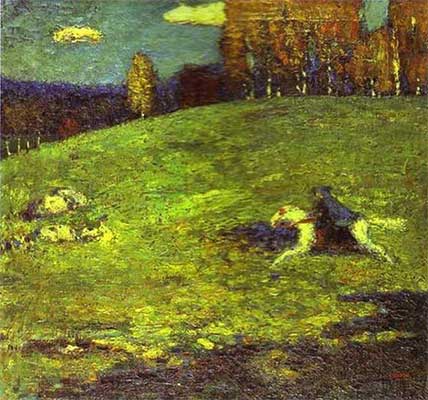
Der Blaue Reiter
This breakthrough canvas is a deceptively simple image - a lone rider racing across a landscape - yet it represents a decisive moment in Kandinsky's developing pictorial language. Here, the sun-dappled hillside reveals a keen interest in contrasts of light and dark as well as movement and stillness, all major themes throughout his oeuvre. Constituting a link between Post-Impressionism and the burgeoning Expressionist movements, Kandinsky's canvas became the emblem of the expressive possibilities embraced by the Munich avant-garde. This is the eponymous work from which the collective derived its name in 1911.
Oil on canvas - Private Collection
Hans Tietze and Erica Tietze-Conrat
The esteemed art historians Hans Tietze and Erica Tietze-Conrat commissioned this portrait by Kokoschka for their art collection. The colorful background and concentrated gestures of the figures represent the couple as "closed personalities so full of tension," as the artist once called them. As in many of his portraits, Kokoschka focuses on the inner drama of his subjects, here, using the couple's nervous hands as a focal point of their anxiety. His rendering depicts the way the artist perceived the couple's psyche, not necessarily their physical, naturalistic appearances. Kokoschka's emotional representation is emblematic of the Expressionist style. The swirling, abstract colors that obscure the background and emerge around them are characteristic of Kokoschka's frenetic, depthless renderings of space throughout his oeuvre.
Oil on canvas - The Museum of Modern Art, New York
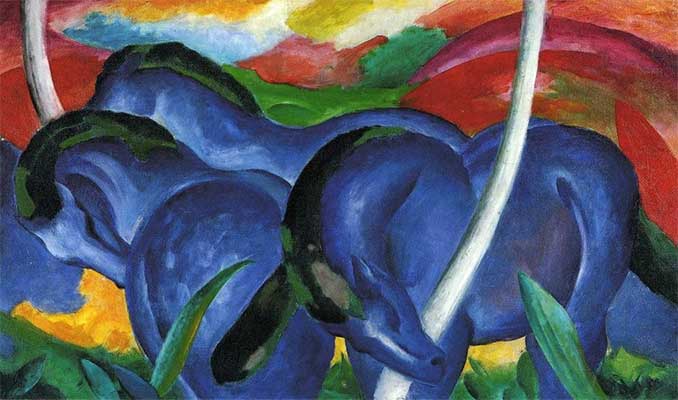
Large Blue Horses
The painter, printmaker, and watercolorist Marc was a key member of Der Blaue Reiter, and is known for his use of animal symbolism. This canvas belonged to a series of works that centered on the theme of horses, which he regarded as emblems of spiritual renewal. The lush colors, fracturing of space, and geometric forms show the influence of Cubism and Robert Delaunay's Orphism. However, while Marc was influenced by his contemporaries, his emphasis on fantastic subjects derived from the material world, such as the blue horses from this 1911 painting, is unique to his practice. For the artist, the movement away from realistic depiction represented a turn towards the spiritual, the emotional, and the authentic. As with many Expressionists, color was symbolic rather than descriptive for Marc. He drew upon the emotive qualities of his palette to convey his vision of the spiritual blue beasts.
Oil on canvas - Walker Art Center, Minneapolis
Houses at Night
After co-founding Die Brücke in Dresden, Schmidt-Rottluff moved to the booming city of Berlin, where he painted this abstracted rendering of a city block. The buildings stagger apart from each other at odd angles over an eerily empty street, evoking the alienation of modern urban society. Even though Schmidt-Rottluff painted Houses at Night, the influence of woodblock printing is clear; the abstracted, minimalist shapes have a stark and graphic quality similar to the artist's many woodblock works. Here, the bright colors add to the primitive shapes of the canvas, imbuing the scene with an underlying sense of unease and estrangement. The pervasive disquiet was the essence of the modern, urban realm for Expressionists. The turn toward jagged forms and a bright, acidic palette emphasized the artist's individual, avant-garde interpretation of the street scene.
Oil on canvas - The Museum of Modern Art, New York
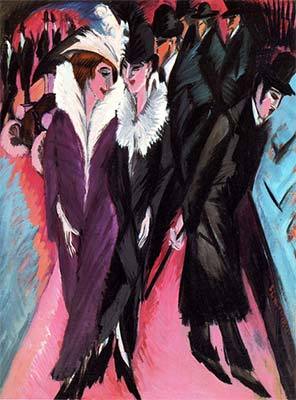
Street, Berlin
Kirchner is renowned for his many Berlin street scenes, and this particular work is perhaps his most well known from that category, if not his entire catalog. His jagged, angular brushstrokes, acidic colors, and elongated forms all charge the street atmosphere on the canvas and achieve something very rebellious for its time and exemplify the stylistic break with tradition that the members of Die Brücke sought. As a founding member of the group, Kirchner set out to establish a new order of painting, one that visibly renounced Impressionistic tendencies and the need to accurately portray figurative forms. In Street, Berlin, Kirchner created a stunningly askew rendition of an alienated, urban street procession. Without regard for realistic depiction of form, he bent and contorted his narrow figures like they were blades of grass in a meadow. Another uniquely modern feature of Street, Berlin was Kirchner's choice to position two prostitutes (identifiable by their signature plumed hats) as the painting's (somewhat off-center) focal point.
Oil on canvas - The Museum of Modern Art, New York
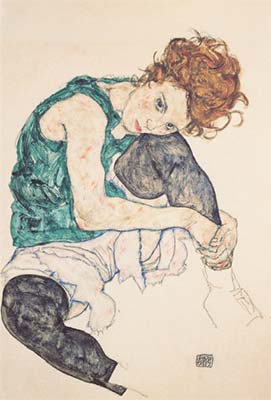
Sitting Woman with Legs Drawn Up
Schiele, one of the central figures of Austrian Expressionism, is known for his jarring and oftentimes grotesque renderings of overt sexuality. Here, Schiele draws his wife, Edith Schiele, partially dressed, her body contorted in an unnatural position. Her bold and intense expression assertively confronts the viewer and directly contradicts the artistic standards of passive feminine beauty. Although unabashedly controversial throughout his lifetime, Schiele was recognized for his skilled draftsmanship and his use of sinewy lines to evoke the decadence and debauchery of modern Austria. The emotive quality of Schiele's line-work and color firmly places him in the Expressionist movement. He rendered images as he interpreted them, not as they appeared to the outside world.
Oil on canvas - National Gallery, Prague
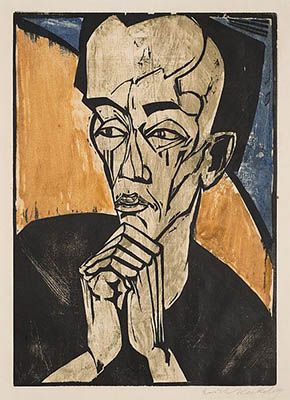
Portrait of a Man
A founding member of Die Brücke, Heckel experimented widely with woodblock printing, a favorite medium of many Expressionists, and was originally attracted to the technique for its raw emotionalism and stark aesthetic, as well as its traditional German heritage. While many of his works depict nudes and scenes of city life, Heckel takes up a more introspective subject in this somber self-portrait from 1919. The figure's drawn face, distorted jaw, and weary eyes, which seem to gaze distractedly into the distance, highlight the individual's spiritual, psychological, and physical fatigue. Rather than create a naturalistic self-portrait, Heckel indicates the general spirit of his time and the national weariness of his age, common themes in Expressionist art.
Woodcut - The Museum of Modern Art, New York
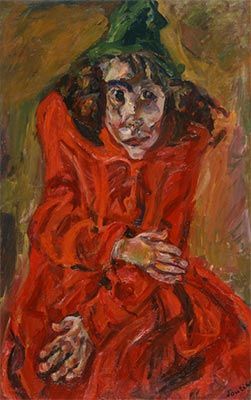
Mad Woman
Soutine painted two known versions of Mad Woman (using a different woman for each), and this was unquestionably the darkest of the pair. His violent brushstrokes and contorted lines communicate an almost unnerving tension, but nevertheless do not deny his subject a rich depth of character. Soutine invited viewers to observe the subject closely, to gaze into her eyes and study her asymmetrical face and form. In many ways, this painting embodies the essence of the Expressionist style; Mad Woman visibly vibrates, contorts, shifts, pushes, and pulls, providing the viewer with Soutine's vision of the inner torment of his sitter. In part, it redefined the genre of portrait painting. Simply by painting this mysterious (and possibly dangerous) woman up close rather than from a distance, Soutine established himself as an empathetic figure, but also as a daring visionary.
Oil on canvas - National Museum of Western Art, Tokyo
Beginnings of Expressionism
With the turn of the century in Europe, shifts in artistic styles and vision erupted as a response to the major changes in the atmosphere of society. New technologies and massive urbanization efforts altered the individual's worldview, and artists reflected the psychological impact of these developments by moving away from a realistic representation of what they saw toward an emotional and psychological rendering of how the world affected them. The roots of Expressionism can be traced to certain Post-Impressionist artists like Edvard Munch in Norway, as well as Gustav Klimt of the Vienna Secession.
Edvard Munch in Norway
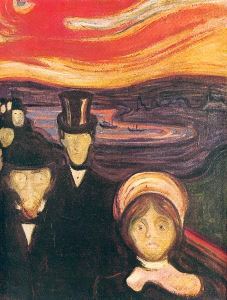
The late-19th-century Norwegian Edvard Munch emerged as an important source of inspiration for the Expressionists. His vibrant and emotionally charged works opened up new possibilities for introspective expression. In particular, Munch's frenetic canvases expressed the anxiety of the individual within the newly modernized European society; his famous painting The Scream (1893) evidenced the conflict between spirituality and modernity as a central theme of his work. By 1905 Munch's work was well known within Germany and he was spending much of his time there as well, putting him in direct contact with the Expressionists. In addition to Munch, the Flemish James Ensor was also an early influence that was studied and built upon.
Gustav Klimt in Austria
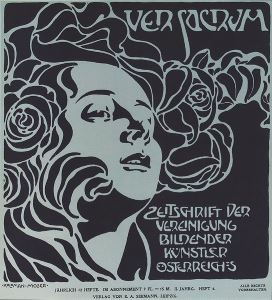
Another figure in the late-19th century that had an impact upon the development of Expressionism was Gustav Klimt, who worked in the Austrian Art Nouveau style and led the Vienna Secession. Klimt's lavish mode of rendering his subjects in a bright palette, elaborately patterned surfaces, and elongated bodies was a step toward the exotic colors, gestural brushwork, and jagged forms of the later Expressionists. Klimt was a mentor to painter Egon Schiele, and introduced him to the works of Edvard Munch and Vincent van Gogh, among others, at an exhibition of their work in 1909.
The Advent of Expressionism in Germany
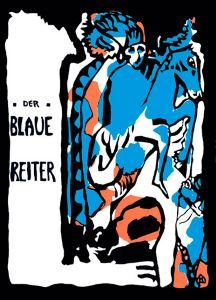
Although it included various artists and styles, Expressionism first emerged in 1905, when a group of four German architecture students who desired to become painters - Ernst Ludwig Kirchner, Fritz Bleyl, Karl Schmidt-Rottluff, and Erich Heckel - formed the group Die Brücke (The Bridge) in the city of Dresden. A few years later, in 1911, a like-minded group of young artists formed Der Blaue Reiter (The Blue Rider) in Munich, after the rejection of Wassily Kandinsky's painting The Last Judgment (1910) from a local exhibition. In addition to Kandinsky, the group included Franz Marc, Paul Klee, and August Macke, among others, all of whom made up the loosely associated group.
The Term "Expressionism"
The term "Expressionism" is thought to have been coined in 1910 by Czech art historian Antonin Matejcek, who intended it to denote the opposite of Impressionism. Whereas the Impressionists sought to express the majesty of nature and the human form through paint, the Expressionists, according to Matejcek, sought only to express inner life, often via the painting of harsh and realistic subject matter. It should be noted, however, that neither Die Brücke, nor similar sub-movements, ever referred to themselves as Expressionist, and, in the early years of the century, the term was widely used to apply to a variety of styles, including Post-Impressionism.
Expressionism: Concepts, Styles, and Trends
Die Brücke: Kirchner, Schmidt-Rottluff, Heckel, and Bleyl
Influenced by artists such as Munch, van Gogh, and Ensor, the members of the Dresden-based Die Brücke group sought to convey raw emotion through provocative images of modern society. They depicted scenes of city dwellers, prostitutes, and dancers in the city's streets and nightclubs, presenting the decadent underbelly of German society. In works such as Kirchner's Street, Berlin (1913), they emphasized the alienation inherent to modern society and the loss of spiritual communion between individuals in urban culture; fellow city dwellers are distanced from one another, acting as mere commodities, as in the prostitutes at the forefront of Kirchner's composition.
Unlike the pastoral scenes of Impressionism and the academic drawings of Neoclassicism, Die Brücke artists used distorted forms and jarring, unnatural pigments to elicit the viewer's emotional response. The group was similarly united by a reductive and primitive aesthetic, a revival of older media and medieval German art, in which they used graphic techniques such as woodblock printing to create crude, jagged forms.
The group published a woodcut broadsheet in 1906, called Programme, to accompany their first exhibition. It summarized their break with prevailing academic traditions calling for a freer, youth-oriented aesthetic. Although mostly written by Kirchner, this poster served as manifesto stating the ideals of Die Brücke. The members of Die Brücke drew largely from the writings of German philosopher Friedrich Nietzsche in terms of both their artistic project and their philosophical grounding. Their name came from a quote from Thus Spoke Zarathustra (1883-85) that states, "What is great in man is that he is a bridge and not an end." The group exhibited and collaborated through 1913, when Kirchner penned Chronik der Brücke (Brücke Chronicle) and the collective effectively dissolved.
Der Blaue Reiter: Kandinsky, Macke, Klee, and Marc
The artists of Der Blaue Reiter group shared an inclination towards abstraction, symbolic content, and spiritual allusion. They sought to express the emotional aspects of being through highly symbolic and brightly colored renderings. Their name emerged from the symbol of the horse and rider, derived from one of Wassily Kandinsky's paintings; for Kandinsky, the rider symbolized the transition from the tangible world into the spiritual realm and thus acted as a metaphor for artistic practice. For other members such as Franz Marc, Paul, Klee, and Auguste Macke, this notion became a central principle for transcending realistic depiction and delving into abstraction.
Although Der Blaue Reiter never published a manifesto, its members were united by their aesthetic innovations, which were influenced by medieval and primitivist art forms, Cubism, and Fauvism. However, the group itself was short-lived; with the outbreak of World War I in 1914, Franz Marc and Auguste Macke were drafted into German military service and were killed soon after. The Russian members of the group - Wassily Kandinsky, Alexej von Jawlensky, and others - were all forced to return home. Der Blaue Reiter dissolved immediately thereafter.
French Expressionism: Rouault, Soutine, and Chagall
Expressionism's elasticity has meant that many artists beyond Germany's borders have been identified with the style. Georges Rouault, the French artist sometimes described as an Expressionist, may have influenced the Germans, rather than the other way around. He learned his vivid use of color and distortion of form from Fauvism, and, unlike his German Expressionist counterparts, Rouault expressed an affinity for his Impressionist predecessors, particularly for the work of Edgar Degas. He is well known for his devotion to religious subjects, and particularly for his many depictions of the crucifixion, rendered in rich color and heavy layers of paint.
The Russian-French Jewish artist Marc Chagall drew upon currents from Cubism, Fauvism, and Symbolism to create his own brand of Expressionism in which he often depicted dreamy scenes of his Belarusian hometown, Vitebsk. While in Paris during the height of the modernist avant-garde, Chagall developed a visual language of eccentric motifs: "ghostly figures floating in the sky, the gigantic fiddler dancing on miniature dollhouses, the livestock and transparent wombs and, within them, tiny offspring sleeping upside down." In 1914, his work was exhibited in Berlin, and had an impact on the German Expressionists extending beyond World War I. He never associated his work with a specific movement, and considered his repertoire to be a vocabulary of images meaningful to himself, but they inspired many, including the Surrealists. Pablo Picasso remarked in the 1950s, "When Matisse dies, Chagall will be the only painter left who understands what color really is."
Chaim Soutine, the Russian-Jewish, Paris-based painter, was a major proponent of the development of Parisian Expressionism. He synthesized elements from Impressionism, the French Academic tradition, and his own personal vision into an individualized technique and version of the style. The artist's expressive style has proved highly influential on subsequent generations.
Austrian Expressionism: Kokoschka and Schiele
Austrian artists such as Oskar Kokoschka and Egon Schiele, were inspired by German Expressionism, but interpreted the style in their individual and personalized manners never forming an official association like the Germans. Kokoschka and Schiele sought to express the decadence of modern Austria through similarly expressive representations of the human body; by sinuous lines, garish colors, and distorted figures, both artists imbued their subjects with highly sexual and psychological themes. Although Kokschka and Schiele were the central proponents of the movement in Austria, Kokoschka became increasingly involved in German Expressionist circles; he left Austria and moved to Germany in 1910. Initially Kokoschka worked in a Viennese Art Nouveau style, but starting in 1908 he instinctively worked as an Expressionist, passionately seeking to expose an inner sensibility of the sitter in his early portraits. Schiele left Vienna in 1912 but remained in Austria, where he worked and exhibited until his death in the worldwide influenza epidemic of 1918.
Later Developments - After Expressionism
While certain artists rejected Expressionism, others would continue to expand upon its innovations as a style. For example, in the 1920s, Kandinsky transitioned to completely non-objective paintings and watercolors, which emphasized color balance and archetypal forms, rather than figurative representation. However, Expressionism would have its most direct impact in Germany and would continue to shape its art for decades afterwards. After World War I, Expressionism began to lose impetus and fragment. The Neue Sachlichkeit (New Objectivity) movement developed as a direct response to the highly emotional tenets of Expressionism, while the Neo-Expressionists emerged in Germany and then in the United States much later in the 20th century, reprising the earlier Expressionist style.
New Objectivity: Dix, Grosz and Beckmann
Already by 1918, the Dada manifesto claimed, "Expressionism...no longer has anything to do with the efforts made by active people." But its ethos would have a vivid afterlife; it was crucial in the early formation of artists Otto Dix, George Grosz, and Max Beckmann, who together formed the movement known as the Neue Sachlichkeit (New Objectivity). These artists sought, as the name suggests, an unsentimental and objective approach to artistic production. Their naturalistic renderings of individuals and urban scenes highlighted this new aesthetic and paralleled the general attitude of practicality that characterized Weimar culture.
Neo-Expressionism: Baselitz, Kiefer, and Schnabel
The emergence of Georg Baselitz's paintings of layered, vibrant colors and distorted figures in the 1960s, and of Anselm Kiefer's images buried amidst thick impasto built up from a variety of materials on the canvas in the 1970s, signaled an important and influential revival of the style within Germany, which would eventually culminate in a global Neo-Expressionist movement in the 1980s. Artists in New York City, like Julian Schnabel, also employed thick layers of paint, unnatural color palettes and gestural brushwork to hearken back to the Expressionist movement earlier in the 20th century.
The original Expressionist movement's ideas about spirituality, primitivism, and the value of abstract art would also be hugely influential on an array of unrelated movements, including Abstract Expressionism. The Expressionists' metaphysical outlook and instinctive discomfort with the modern world impelled them to antagonistic attitudes that would continue to be characteristic of various avant-garde movements throughout the century.
Useful Resources on Expressionism
- ExpressionismOur PickBy Norbert Wolf, Uta Grosenick
- German Expressionist PaintingOur PickBy Peter Selz
- Expressionism: The Graphic ImpulseBy Peter Jelavich, Heather Hess, Starr Figura
- Expressionism: A Revolution in German ArtBy Dietmar Elger
- The Era of German ExpressionismBy Paul Raabe
- German Expressionism: Documents from the End of the Wilhelmine Empire to the Rise of National SocialismBy Rose-Carol Washton Long
